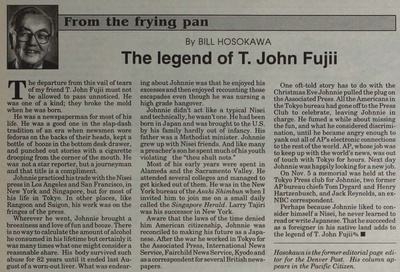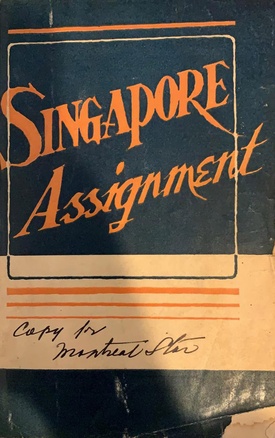T. John Fujii’s career in wartime Singapore, as discussed in his book Singapore Assignment, offers a stark lesson in the ambiguity of Nisei responses to the conflict of loyalties between the United States and Japan in the era of the Pacific War. During these years, a whole cadre of educated Nisei, who had been excluded on racial grounds from employment with mainstream American businesses, and had accepted positions with Japanese firms in North America and in Japan’s growing empire in Asia, were caught in the middle of the growing Japanese-U.S. conflict. They were forced to maneuver and negotiate between loyalty to their native land, their economic prospects, and their responsibility to their employers.
For Fujii, the problem of loyalty and identity was even keener because of the circumstances of his birth. In fall 1985, he attended a conference at UCLA. “Coming of Age in the 1930s,” on prewar Nisei writers and journalists. At the conference, Fujii described himself as a “Kibei in reverse”: The Kibei were Nisei, born in the United States, who were sent to Japan for their education, then had difficulty acculturating themselves after returning to America. Fujii, who was born in Japan, came to the United States as a baby and had his entire education there, then moved to Japan after World War II. Despite his long residence in the land of his birth, he never learned to read or speak Japanese, and always considered himself a Nisei.
So why, then, did Fujii to accept a position with the Singapore Herald in 1939? The Herald’s creation as a mouthpiece for Tokyo, as part of a worldwide propaganda push, was an open secret. (The Japanese government denied that it financed the newspaper, but the Japanese foreign ministry in fact offered a subsidy, one that enabled its editors to reduce the price to three cents a copy, undercutting other Singapore dailies that charged five cents). Fujii was clearly aware that the position was a form of entry into future propaganda work. “The Nisei future is in the Far East with Japan’s destiny in Asia,” he told an unnamed interviewer (likely Larry Tajiri) in March 1939, while en route to Asia. "I expect to stay in Singapore for two or three years, and later return to Tokyo, to work with the Foreign Office in propaganda work. Japan is in need of trained men and more Nisei should take advantage.”
In Larry Tajiri’s view, expressed in the early postwar years, the fact that Fujii was barred from U.S. citizenship, unlike his American-born Nisei counterparts, was decisive in his actions: “He could not vote. He could not own property in the state of California. Many jobs and most professions were closed to him. His status influenced his political opinions, or lack of them. His status, or lack of it, made him opportunistic.” In contrast to Tajiri, the liberal activist, Fujii held to the position that a journalist should confine himself to objective reporting and not advocate for any position, either through journalism or outside actions. Ironically, such a stance of detachment and lack of political viewpoint bred opportunism. Since Fujii was excluded on racial grounds from working on mainstream American newspapers, he would look to the Far East, where he could obtain such chances.
Tajiri’s position is illuminating, since in 1940 he himself took over the job as New York correspondent of the Asahi newspapers that Fujii had left behind, and remained in that position until Pearl Harbor. Tajiri may have done his best to balance objective reporting against the pressures of the job, and felt some discomfort. Still, in speaking about Fujii’s opportunism, he may have opened himself to charges of protesting too much. Tajiri further stated, moreover, that once he was in New York, Fujii invited him to come work together on the Singapore Herald, and promised him not only round-trip passage on an ocean liner for himself and his wife, but a vacation trip to Bali. Tajiri adds that he turned down the invitation, mostly for ideological reasons.
Yet if the Singapore Herald was so ideologically objectionable, more so than the Asahi position, what then are we to make of the fact that its first editor was Bill Hosokawa? As his future career showed, Hosokawa was a patriotic American, and not a simple-minded shill or Japanese propagandist. All the same, the Herald under Hosokawa’s editorship expressed from the outset a certain pro-Japanese bias. The newspaper supported Japan’s position in international affairs and criticized what it called the “Chungking faction” (i.e. the official Chinese government that had moved to Chungking to escape the Japanese occupation). True, once Hosokawa left the editorship, under Fujii’s editorship the Herald took a stand that was more openly critical of the colonial government of Singapore. However, according to later accounts, even Fujii was convinced that Japan and the Western powers could find some accommodation, and he deprecated the possibility of war.
Fujii’s is more open to charges of opportunism and pro-Japanese propaganda for his 1943 book Singapore Assignment. In it, Fujii presents himself as adjusting psychologically from an American to a Japanese point of view, and offers fulsome praise for Japan and for Tokyo’s “mission of Greater East Asia.” Yet, even publishing amid Japanese wartime censorship, he speaks positively of the Americans he met in prewar Singapore, who had a measure of “tolerant understanding.”
In contrast, Fujii devotes his most powerful passages to attacking the smug and pretentious British in Singapore, and their economic exploitation of the Malay and Chinese population. He draws a strong parallel between the attitude of the British in the Straits, who treated the native population as inferiors, and racial discrimination against Nisei in the USA. “The more I saw of British life, the more I learned to hate their smug arrogance. The Americans that I had known in my childhood were narrow-minded and prejudiced but the British in Singapore were ten times worse.”
There is also an intermittent nasty tone of anti-Semitism in the book (one that had already appeared sporadically in Fujii’s writings in the prewar Nisei press). For example, Fujii dismisses a rival publication, the Malaya Tribune, as a tool of its Chinese and Jewish capitalist owners. “[It] was the Chinese capital that remained, coupled with Jewish greed, that made the Malaya Tribune prostitute itself to Chungking propaganda. On the whole the Malaya Tribune was a poorly edited newspaper. In its endeavor to please both its Jewish management and Chungking support, the Tribune was at best a cheap, sensational journal.”
John Fujii’s writings in the prewar Singapore Herald made him a controversial figure. During World War II two books were published which commented on him. In his 1943 book, Suez to Singapore, CBS radio correspondent Cecil Brown called him "Johnny Fuji, the Japanese spy." According to Brown, Fujii was a Japanese agent who had been stationed in Singapore in the months before Pearl Harbor to entertain visiting American dignitaries, newsmen and others at bars and at dinners, and lure them into offering confidential information.
Fujii’s Nisei friends such as Larry Tajiri, who were aware of his fondness for going out on the town, responded by accusing Brown of having mistaken such friendliness for an officially-inspired effort to get information. Rather, they claimed rather poignantly, these were the actions of a homesick American who desperately wanted to talk with someone from his home country." Mark J. Gayn, an authority on Far Eastern affairs who had attended school with Fujii at Pomona College, likewise took a more generous view in his 1944 memoir, Journey from the East, seeing Fujii primarily as a victim of circumstances.
Even once the war ended, Fujii remained controversial. In 1946 the Singapore newspaper Morning Tribune reported the shocking information that “Johnny Fuji,” the man about town and ex-Japanese agent, was now at large in town, making money by interpreting for the Australian occupiers and tooling around in a jeep wearing a white suit and a solar topee. Its article presented on page one a set of anti-British quotes from Singapore Assignment, which it referred to as a “notorious, news-distorted book.” Shortly afterwards, Columnist Leonard Lyons reported with shock that Fujii had returned to Japan, where he been screened by US occupation authorities and approved for a job with an American news service (INS).
What was Fujii’s own attitude toward his identity and his wartime actions? One useful clue might be a review he did in the Yomiuri English News of the first edition of John Okada’s epochal 1957 novel, No-No Boy. Fujii started his review by giving a curious version of the history of Executive Order 9066: “The outbreak of World War II threw them all into American-style concentration camps out of which the majority either volunteered or were drafted into the US armed services. The nisei fought heroically as the 442nd Regimental Combat Team to prove that they were ‘good Americans.’ But after the war, many found that the battle had just been joined.” (It is unknown whether the experience of Fujii’s brother Henry, who was confined in camp and later enlisted in the U.S. Army, played a role in this all-male and militarist conception of the Nisei generation).
Fujii went on to describe Nisei unflatteringly as searching for their identity within a country that only partially accepted them, as with other “hyphenated Americans,” and being “filled with such bitterness.” In contrast, those (implicitly like himself) who had embraced Japan were at peace with themselves. “Many nisei who sought an identity, gave up the land of their birth, and returned to Japan before the war. They had their tribulations, their period of adjustment during the war as they tried to fit themselves into a society that was ruled by kempeis [Kempeitai, Japanese military secret police] and the brutal sergeants. But these Japanese-Americans, who dropped the second half of their hyphenated nomenclature, served in Japanese intelligence corps, as front-line combat reporters, as voice interceptors in submarines and as staff interpreters during the surrender ceremonies. Few of these individuals will admit any regrets, if they have any, at this late stage.”
Fujii’s brave words about resolving his identity crisis and adopting a unitary Japanese identity are belied by the record. Fujii never learn to speak or read Japanese language, and he took every opportunity he could to connect with other Nisei. When wartime Japanese American Citizens League president Saburo Kido visited Japan in the late 1950s, Fujii jumped at the chance to meet him. In 1974, Fujii called for the founding of a JACL chapter in Tokyo, and took steps towards organizing it. In 1983 Fujii organized a reunion dinner of the staff of the Singapore Herald, and invited his old boss Bill Hosokawa to attend. After Fujii died in 1996, Hosokawa would include a reminiscence of his old friend in his “Frying Pan” column in Pacific Citizen.

* Author's note: Junhan Yu contributed to the research for this article.
© 2020 Greg Robinson







